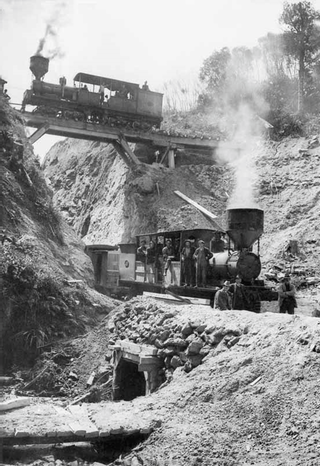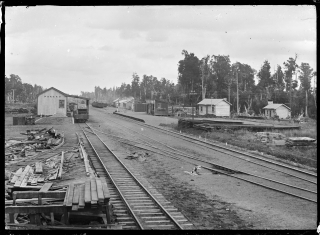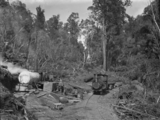
The Raurimu Spiral is a single-track railway spiral, starting with a horseshoe curve, overcoming a 139-metre (456 ft) height difference, in the central North Island of New Zealand, on the North Island Main Trunk railway (NIMT) between Wellington and Auckland. It is a notable feat of civil engineering, having been called an "engineering masterpiece." The Institute of Professional Engineers of New Zealand has designated the spiral as a significant engineering heritage site.

The New Zealand F class was the first important class of steam locomotive built to operate on New Zealand's railway network after the national gauge of 3 ft 6 in was adopted. The first locomotives built for the new gauge railways were two E class double Fairlies for the Dunedin and Port Chalmers Railway Company. The F class was the first class ordered by the central government, and between 1872 and 1888, a total of eighty-eight members of the class were constructed.

Thomas Green & Son, Ltd. were engineers who manufactured a wide range of products at the Smithfield Foundry, Leeds, United Kingdom

A tram engine is a steam locomotive specially built, or modified, to run on a street, or roadside, tramway track.

Trams in New Zealand were a major form of transport from the 19th century into the mid-20th century. New Zealand's first (horse) tramway was established in 1862 (Nelson), followed by a steam tramway in 1871 (Thames), and the first electric tramway in 1900. In New Zealand railway terminology a bush tramway is an industrial tramway, which usually did not carry passengers.

The Powelltown tramway was a 3 ft narrow gauge tramway that operated between Powelltown and Yarra Junction, Victoria, Australia, between 1913 and 1945.

The earliest trams in Australia operated in the latter decades of the 19th century, hauled by horses or "steam tram motors". At the turn of the 20th century, propulsion almost universally turned to electrification, although cable trams lingered in Melbourne. In cities and towns that had trams, they were a major part of public transport assets.

A & G Price Limited is an engineering firm and locomotive manufacturer in Thames, New Zealand founded in 1868.

The Ellis & Burnand Tramway was from 1922 to 1958 a 37 kilometres (23 mi) long bush tramway near Ongarue in the central North Island of New Zealand with a gauge of 3 ft 6 in.

The Makatote Tramway was from the late 1920s to 1940 a 2.6 kilometres (1.6 mi) long bush tramway network near Makatote in the central North island of New Zealand with a gauge of 4 feet 1 inch (1,245 mm) using metal and wooden rails. It was operated by Dinwoodie's Timber Company with probably less than 10 employees.

Taringamotu Tramway, nicknamed Taringamotu Express, was a bush tramway near Oruaiwi, also known as Waituhi, a settlement in the valley of Taringamotu in the Manawatū-Whanganui region of New Zealand's North Island. It operated from 1910 to the mid 1960s.

The Mountain Rimu Timber Company owned and operated a bush tramway near Mamaku, south of the Kaimai Range near Rotorua in the Bay of Plenty Region of the North Island of New Zealand. The tramway, with a track gauge of 3+1⁄2 feet (1,067 mm), was used from approximately 1898, to at least 1935.

The May Morn Estates Tramway was a bush tramway at Mangaroa, which crossed the Hutt River at Te Mārua near Upper Hutt on New Zealand's North Island. The company was incorporated in 1912 and operated their saw mill at least from 1914 to 1915.

The Charming Creek Tramway was a 9 kilometres (5.6 mi) long private bush tramway at Ngakawau in Buller District on the West Coast in New Zealand. It was used from 1903 or 1905 to 1958.

The Hokitika & Kanieri Tramway was an 3.5 kilometres (2 mi) long, privately owned bush tramway with a gauge of 3 ft 6 in between Hokitika and Kaniere in the Westland District on the West Coast of the South Island, New Zealand, which operated from 1866 to 1914 as a horse-drawn tram and from the 1920s to 1950s as a logging railway.

Raurimu railway station was a station on the North Island Main Trunk, and in the Manawatū-Whanganui region.

Hīhītahi was a station on the North Island Main Trunk line, in the Rangitikei District of New Zealand, in the Hautapu River valley. The station served the settlement of Hīhītahi, which was big enough to have a store and a school. It was 12.55 km (7.80 mi) south of Waiouru and 3.05 km (1.90 mi) north of Turangarere. Hīhītahi is at the top of a 1 in 70 gradient from Mataroa, so that it is 39 m (128 ft) above Turangarere, but only 73 m (240 ft) below the much more distant Waiouru.

Pokaka was a station on the North Island Main Trunk line, in the Ruapehu District of New Zealand. It served the small village of Pokaka and lay to the south of Makatote Viaduct, the late completion of which held up opening of the station.

Erua was a station on the North Island Main Trunk line, in the Ruapehu District of New Zealand. It served the small village of Erua. For a month in 1908 it was the terminus of the line from Auckland. Makatote Viaduct and tramway are about 3 mi (4.8 km) south of Erua.























